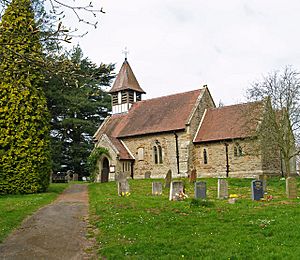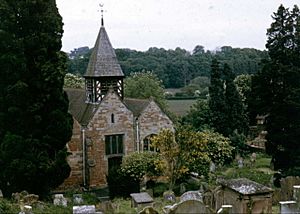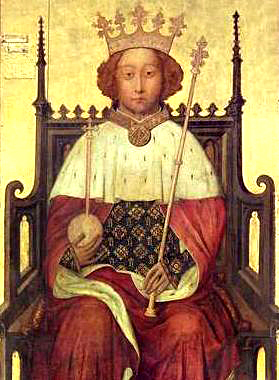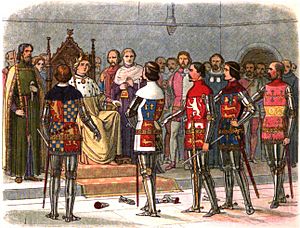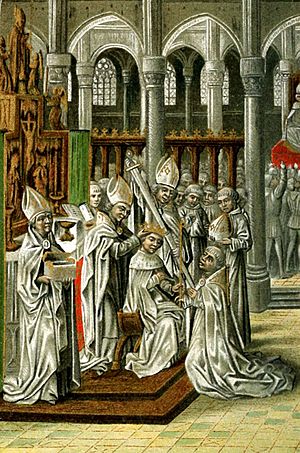John Darras facts for kids
Quick facts for kids
Sir
John Darras
|
|
|---|---|
| Member of the English Parliament for Shropshire |
|
| In office 20 January 1393 – 10 February 1393 Serving with Sir William Hugford
|
|
| Preceded by | Sir Hugh Cheyne, Sir Roger Corbet (died 1395) |
| Succeeded by | Sir Adam Peshale, Sir William Hugford |
| In office 6 October 1404 – 13 November 1404 Serving with John Burley
|
|
| Preceded by | John Burley, George Hawkestone |
| Succeeded by | David Holbache, Thomas Whitton |
| Personal details | |
| Born | c. 1355 |
| Died | March 1408 Neenton |
| Nationality | English |
| Spouse | Joan Corbet (died c. 1400) |
| Relations | Sir Roger Corbet (brother-in-law) |
| Occupation | Landowner, soldier. |
John Darras (around 1355–1408) was an English soldier, politician, and landowner. He fought in the Hundred Years' War and against the Glyndŵr Rising in Wales. John Darras worked closely with the powerful FitzAlan Earls of Arundel. He helped them control his home county of Shropshire. He was chosen twice to represent Shropshire in the House of Commons of England. He died in 1408.
Contents
Early Life and Family Background
John Darras was the son of Ralph Darras and Joan Forcer. His mother, Joan, was an heiress from the Forcer and Ribbesford families. The Darras family were not very rich landowners. They were part of the growing group of landed gentry.
John's father, Ralph Darras, owned the manors (large estates) of Neenton and Sidbury in Shropshire. These areas were part of the Welsh Marches, which bordered Wales. The family name "Darras" comes from "de Arras," meaning they originally came from Arras in Flanders.
Ralph Darras died in December 1361, when John was only about seven years old. This was during a time when the Black Death was spreading again in Shropshire. The plague caused big changes in the economy. Land was left unplanted, and some landowners found it hard to pay even small rents. This difficult economic situation shaped John Darras's life. He worked hard to gain more land and find other ways to earn money, like through business and military service.
John's mother, Joan, also likely died when he was young. He had to fight legal battles to secure his inheritance, working with his aunts.
Becoming a Landowner
After his father's death, John Darras inherited the manors of Sidbury and Neenton. He held these lands from Edmund Mortimer, 3rd Earl of March. In return, he had to provide a hobelar (a light cavalry soldier) for Wigmore Castle during wars in the Welsh Marches. He also owned small parts of other lands, like a third of the manor of Linley.
John Darras had a small amount of inherited land. He often used legal actions, and sometimes even force, to try and get more land. However, he had limited success.
In 1379 and 1383, John Darras and his aunts, Burga and Elizabeth, fought over the ownership of Ribbesford and Rock, Worcestershire. These lands had belonged to their relative, Sir Henry Ribbesford. They won their case, but the lands soon ended up with Thomas de Beauchamp, 12th Earl of Warwick.
Church Patronage and Business Dealings
John Darras gained the right to choose the priests for churches on most of his estates. This was a valuable right. For example, he could appoint the rector (priest) of Sidbury church. In 1386, he arranged for a new priest, Philip Kentles, to come to Sidbury. In 1392, he appointed another priest after Philip died. He also chose the priest for Neenton church in 1399.
As a significant landowner, Darras was trusted by other local gentry. He helped others with land deals, including Malcolm de la Mare and Thomas Whitton. These business partners often became his personal and family allies throughout his career.
| Family tree to illustrate the Ribbesford property disputes | ||||||||||||||||||||||||||||||||||||||||||||||||||||||||||||||||||||||||||||||||||||||||||||||||||||||||||||||||||||||||||||||||||||||||||||||||||||||||||||||||||||||||||||||||||||||||||||||||||||||||||||||||||||||||||||||||||||||||||||||||||||||||||||||||||||||||||||||||||||||||||||||||||||||||||||||||||||||||||||||||||||||||||||||||||||||||||||||||||||||||||||||||||||||||||||||||||||||||||||||||||||||||||||||||||||||||||||||||||||||||||||||||||||||||||||||||||||||||||||||||||||||||||||||||||||||||||||||||||||||||||||||||||||||||||||||||||||||||||||||||||||||||||||||||||||||||||||||||||||||||||||||||||||||||||||
|---|---|---|---|---|---|---|---|---|---|---|---|---|---|---|---|---|---|---|---|---|---|---|---|---|---|---|---|---|---|---|---|---|---|---|---|---|---|---|---|---|---|---|---|---|---|---|---|---|---|---|---|---|---|---|---|---|---|---|---|---|---|---|---|---|---|---|---|---|---|---|---|---|---|---|---|---|---|---|---|---|---|---|---|---|---|---|---|---|---|---|---|---|---|---|---|---|---|---|---|---|---|---|---|---|---|---|---|---|---|---|---|---|---|---|---|---|---|---|---|---|---|---|---|---|---|---|---|---|---|---|---|---|---|---|---|---|---|---|---|---|---|---|---|---|---|---|---|---|---|---|---|---|---|---|---|---|---|---|---|---|---|---|---|---|---|---|---|---|---|---|---|---|---|---|---|---|---|---|---|---|---|---|---|---|---|---|---|---|---|---|---|---|---|---|---|---|---|---|---|---|---|---|---|---|---|---|---|---|---|---|---|---|---|---|---|---|---|---|---|---|---|---|---|---|---|---|---|---|---|---|---|---|---|---|---|---|---|---|---|---|---|---|---|---|---|---|---|---|---|---|---|---|---|---|---|---|---|---|---|---|---|---|---|---|---|---|---|---|---|---|---|---|---|---|---|---|---|---|---|---|---|---|---|---|---|---|---|---|---|---|---|---|---|---|---|---|---|---|---|---|---|---|---|---|---|---|---|---|---|---|---|---|---|---|---|---|---|---|---|---|---|---|---|---|---|---|---|---|---|---|---|---|---|---|---|---|---|---|---|---|---|---|---|---|---|---|---|---|---|---|---|---|---|---|---|---|---|---|---|---|---|---|---|---|---|---|---|---|---|---|---|---|---|---|---|---|---|---|---|---|---|---|---|---|---|---|---|---|---|---|---|---|---|---|---|---|---|---|---|---|---|---|---|---|---|---|---|---|---|---|---|---|---|---|---|---|---|---|---|---|---|---|---|---|---|---|---|---|---|---|---|---|---|---|---|---|---|---|---|---|---|---|---|---|---|---|---|---|---|---|---|---|---|---|---|---|---|---|---|---|---|---|---|---|---|---|---|---|---|---|---|---|---|---|---|---|---|---|---|---|---|---|---|---|---|---|---|---|---|---|---|---|---|---|---|---|---|---|---|---|---|---|---|---|---|---|---|---|---|---|---|---|---|---|---|---|---|---|---|---|---|---|---|---|---|---|---|---|---|---|---|---|---|---|---|---|---|---|---|---|---|---|---|---|---|---|---|---|---|---|---|---|---|---|---|---|---|---|---|---|---|---|---|---|---|---|---|---|---|---|---|---|---|---|---|---|---|---|---|---|---|---|---|---|---|---|---|---|---|---|---|---|---|---|---|---|---|---|---|---|---|---|---|---|---|---|---|---|---|---|---|---|---|---|---|---|---|---|---|---|
|
Derived from the table given by Wrottesley. and further information from the Victoria County History.
|
||||||||||||||||||||||||||||||||||||||||||||||||||||||||||||||||||||||||||||||||||||||||||||||||||||||||||||||||||||||||||||||||||||||||||||||||||||||||||||||||||||||||||||||||||||||||||||||||||||||||||||||||||||||||||||||||||||||||||||||||||||||||||||||||||||||||||||||||||||||||||||||||||||||||||||||||||||||||||||||||||||||||||||||||||||||||||||||||||||||||||||||||||||||||||||||||||||||||||||||||||||||||||||||||||||||||||||||||||||||||||||||||||||||||||||||||||||||||||||||||||||||||||||||||||||||||||||||||||||||||||||||||||||||||||||||||||||||||||||||||||||||||||||||||||||||||||||||||||||||||||||||||||||||||||||
Marriage and Family Life
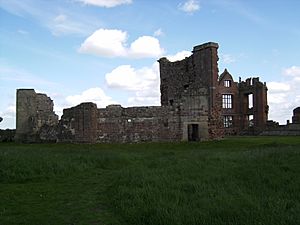
John Darras married Joan Corbet sometime before 1390. This marriage likely happened around 1387, the same year Darras officially joined the powerful Arundel family group.
Joan Corbet was the daughter of Sir Robert Corbet of Moreton Corbet. Her mother was Elizabeth Le Strange, from another important family of Marcher Lords (lords who controlled lands along the Welsh border). Joan was a widow when she married Darras. She had a daughter named Alice from her first marriage.
Joan brought many properties to the marriage. These lands came from her own family and her first husband. They greatly increased Darras's wealth and security while she was alive. These properties included lands in Shropshire (Harley, Gretton, Willey, Kenley) and Worcestershire (Hampton Lovett).
Joan was probably older than John Darras. It is not clear if they had children together, though Darras might have had a son named Roger. Joan seems to have died around 1400. After her death, most of her properties left Darras's control. This led him to actively seek new ways to earn money.
Joan's family, the Corbets of Moreton Corbet Castle, were a rising gentry family. They were growing their estates and influence. Both the Corbets and Darras sought support from the FitzAlans, the Earls of Arundel. The Arundels were the most powerful family in Shropshire and among the richest in England.
Corbet Family Land Disputes
Joan Corbet's brother, Sir Roger, was often involved in family arguments over land. Many of these arguments included Joan. John Darras naturally supported his wife's side. This sometimes caused problems for him with the king and his government.
Roger Corbet had two older brothers and a younger brother, as well as sisters, including Joan. Their parents, Robert and Elizabeth Corbet, wanted to keep the family lands together. This was difficult because people often had short lives, and inheritance rules were complicated. They tried to prevent lands from going to their granddaughter Elizabeth, who married Sir John Ipstones.
After Roger's brother Fulk died in 1382, more problems arose. Some of the family's land agreements contradicted each other. Fulk's daughter, also named Elizabeth, claimed ownership of lands that had been given to Joan and her first husband for their lives. These lands were in western Shropshire, near the Welsh border. Joan, however, wanted the lands to go to her younger brother, Roger. Roger won the case in 1385.
When Fulk's daughter Elizabeth became an adult in 1390, the issue was reopened. Elizabeth was now married to John Mawddwy, who strongly pursued his wife's claim. John Darras, married to Joan, just as strongly supported Joan and Roger. The king, Richard II, was told that the fighting was disturbing the peace in Shropshire.
Darras was ordered to appear before the king's court in June 1390. Other family members and allies were also called. The king took control of the disputed lands for a while, which was profitable for him. Eventually, an agreement was reached in April 1391. It seems the lands went to the Mawddwys. However, Joan and Darras likely received regular rent from them. This was a common way for landowners in Shropshire to get a steady income.
| Family tree to illustrate the Corbet property disputes | ||||||||||||||||||||||||||||||||||||||||||||||||||||||||||||||||||||||||||||||||||||||||||||||||||||||||||||||||||||||||||||||||||||||||||||||||||||||||||||||||||||||||||||||||||||||||||||||||||||||||||||||||||||||||||||||||||||||||||||||||||||||||||||||||||||||||||||||||||||||||||||||||||||||||||||||||||||||||||||||||||||||||||||||||||||||||||||||||||||||||||||||||||||||||||||||||||||||||||||||||||||||||||||||||||||||||||||||||||||||||||||||||||||||||||||||||||||||||||||||||||||||||||||||||||||||||||||||||||||||||||||||||||||||||||||||||||||||||||||||||||||||||||||||||||||||||||||||||||||||||||||||||||||||||||||||||||||||||||||||||||||||||||||||||||||||||||||||||||||||||||||||||||||
|---|---|---|---|---|---|---|---|---|---|---|---|---|---|---|---|---|---|---|---|---|---|---|---|---|---|---|---|---|---|---|---|---|---|---|---|---|---|---|---|---|---|---|---|---|---|---|---|---|---|---|---|---|---|---|---|---|---|---|---|---|---|---|---|---|---|---|---|---|---|---|---|---|---|---|---|---|---|---|---|---|---|---|---|---|---|---|---|---|---|---|---|---|---|---|---|---|---|---|---|---|---|---|---|---|---|---|---|---|---|---|---|---|---|---|---|---|---|---|---|---|---|---|---|---|---|---|---|---|---|---|---|---|---|---|---|---|---|---|---|---|---|---|---|---|---|---|---|---|---|---|---|---|---|---|---|---|---|---|---|---|---|---|---|---|---|---|---|---|---|---|---|---|---|---|---|---|---|---|---|---|---|---|---|---|---|---|---|---|---|---|---|---|---|---|---|---|---|---|---|---|---|---|---|---|---|---|---|---|---|---|---|---|---|---|---|---|---|---|---|---|---|---|---|---|---|---|---|---|---|---|---|---|---|---|---|---|---|---|---|---|---|---|---|---|---|---|---|---|---|---|---|---|---|---|---|---|---|---|---|---|---|---|---|---|---|---|---|---|---|---|---|---|---|---|---|---|---|---|---|---|---|---|---|---|---|---|---|---|---|---|---|---|---|---|---|---|---|---|---|---|---|---|---|---|---|---|---|---|---|---|---|---|---|---|---|---|---|---|---|---|---|---|---|---|---|---|---|---|---|---|---|---|---|---|---|---|---|---|---|---|---|---|---|---|---|---|---|---|---|---|---|---|---|---|---|---|---|---|---|---|---|---|---|---|---|---|---|---|---|---|---|---|---|---|---|---|---|---|---|---|---|---|---|---|---|---|---|---|---|---|---|---|---|---|---|---|---|---|---|---|---|---|---|---|---|---|---|---|---|---|---|---|---|---|---|---|---|---|---|---|---|---|---|---|---|---|---|---|---|---|---|---|---|---|---|---|---|---|---|---|---|---|---|---|---|---|---|---|---|---|---|---|---|---|---|---|---|---|---|---|---|---|---|---|---|---|---|---|---|---|---|---|---|---|---|---|---|---|---|---|---|---|---|---|---|---|---|---|---|---|---|---|---|---|---|---|---|---|---|---|---|---|---|---|---|---|---|---|---|---|---|---|---|---|---|---|---|---|---|---|---|---|---|---|---|---|---|---|---|---|---|---|---|---|---|---|---|---|---|---|---|---|---|---|---|---|---|---|---|---|---|---|---|---|---|---|---|---|---|---|---|---|---|---|---|---|---|---|---|---|---|---|---|---|---|---|---|---|---|---|---|---|---|---|---|---|---|---|---|---|---|---|---|---|---|---|---|---|---|---|---|---|---|---|---|---|---|---|---|---|---|---|---|---|---|---|---|---|---|---|---|---|---|---|---|---|---|---|---|---|---|---|---|---|---|---|---|---|---|---|---|---|---|---|---|---|---|---|---|---|---|---|---|---|---|---|---|---|---|---|---|---|---|---|---|---|---|---|---|---|---|---|---|---|---|---|---|---|---|---|---|---|---|---|---|---|---|---|---|---|---|---|
|
Based on pedigrees derived from the Heraldic Visitation of Shropshire, 1623, and in Augusta Corbet's family history, supplemented by more recent information from the History of Parliament Online.
|
||||||||||||||||||||||||||||||||||||||||||||||||||||||||||||||||||||||||||||||||||||||||||||||||||||||||||||||||||||||||||||||||||||||||||||||||||||||||||||||||||||||||||||||||||||||||||||||||||||||||||||||||||||||||||||||||||||||||||||||||||||||||||||||||||||||||||||||||||||||||||||||||||||||||||||||||||||||||||||||||||||||||||||||||||||||||||||||||||||||||||||||||||||||||||||||||||||||||||||||||||||||||||||||||||||||||||||||||||||||||||||||||||||||||||||||||||||||||||||||||||||||||||||||||||||||||||||||||||||||||||||||||||||||||||||||||||||||||||||||||||||||||||||||||||||||||||||||||||||||||||||||||||||||||||||||||||||||||||||||||||||||||||||||||||||||||||||||||||||||||||||||||||||
Political and Military Career
In 1387, John Darras officially joined the group of followers of Richard FitzAlan, 11th Earl of Arundel. Arundel was a powerful leader who opposed King Richard II's policies. Darras served with Arundel in a naval battle against the French, where they won a big victory.
As a supporter of the Earl, Darras was made a trustee of lands belonging to Richard, 4th Lord Talbot. Talbot was married to Arundel's niece. In 1393, Darras served as a Member of Parliament (MP) for Shropshire for about three weeks. His fellow MP was Sir William Hugford.
In 1397, Earl Arundel was executed by King Richard II. Darras still had good connections with the Lancastrian family, who would later take the throne. When Henry Bolingbroke (John of Gaunt's son) challenged Richard II in 1399, the Arundels supported Henry. Henry became King Henry IV.
Darras managed to stay in the king's favor. In 1399, he was made keeper for life of Morfe and Shirlet Forests in Shropshire. These were royal forests. In 1407, after his loyal service against the Glyndŵr Rising in Wales, the king confirmed his position. Darras was called the "king's esquire" and could even appoint a deputy to help him.
Serving as Sheriff and MP
His connection with the FitzAlans likely led to his appointment as High Sheriff of Shropshire for 1401-1402. Before he became sheriff, his friend Sir John Cornwall was accused of stealing cattle. Cornwall was a relative of Darras's wife. Darras was one of four local gentlemen who promised that Cornwall would keep the peace.
When Cornwall's case moved to court, it was claimed that Darras allowed Cornwall to choose the jurors (people who decide the case). The jury was dismissed, and Darras was ordered to find new jurors. Darras was also the officer who oversaw Cornwall's election to Parliament. Cornwall was a respected man but also known for violence.
The 12th Earl of Arundel, Thomas FitzAlan, had a very strong hold on power in the region. He controlled who was elected to Parliament. In 1404, Darras was again sent to Parliament with John Burley. Burley was a lawyer who worked for the FitzAlans and had fought with Darras in the naval campaign of 1387.
In 1406, Darras and Roger Willey bought two properties without the king's permission. They had to pay a small fine to get a pardon. They then resold these properties without permission again. The new buyer had to get a pardon after Darras died.
In 1407, Darras, along with Robert Corbet and Roger Corbet (Joan's nephews), and William Ryman, gave a property in Shrewsbury called Ireland Hall to Shrewsbury Abbey. This was for religious purposes. The abbey paid a large sum for the right to accept this gift. The younger Corbets were known for being violent. They likely gave Ireland Hall on behalf of Earl Arundel. Later that year, Darras attended the election of knights of the shire, which was his last important public appearance.
Death and Aftermath
John Darras died in March 1408. His death was unexpected. After his death, the king ordered his estates to be taken into royal control. This was partly because the young Edmund Mortimer, 5th Earl of March, who was his feudal lord, was involved in plots against King Henry IV.
Darras's death led to much confusion and arguments over his lands. At Sidbury, there was a dispute over who could choose the new priest. Different people claimed the right. Eventually, John Talbot, 6th Baron Furnivall, gained control of Sidbury. Talbot was a powerful rival to Arundel in the county. The same thing happened at Linley, which also fell into Talbot's hands.
There were also problems with Darras's role as keeper of Morfe and Shirlet Forests. Soon after Darras died, the king gave the job to Sir John Cornwall. However, Cornwall proved to be a harsh keeper. People complained about him taking advantage of forest rights. The king ordered Arundel's legal team to investigate. Eventually, Cornwall resigned, and Roger Willey, Darras's old business partner, became the new keeper in 1413.
See also
- Bastard feudalism
- Corbet family


